- Get link
- X
- Other Apps
11 Stunning Epoxy Flooring Ideas for Your Home
© 2025 Quality Coatings LLC - All Rights Reserved.
Quality Coatings LLC at 419-551-1064
Serving the Greater Fort Wayne and Tri-State area.
Epoxy flooring is a fantastic choice for those looking to spruce up their space with a durable and stylish surface. This versatile option offers a sleek finish that's perfect for both residential and commercial settings. With its resistance to stains, chemicals, and wear, epoxy flooring not only looks great but also stands the test of time. Whether you're updating your garage, basement, or retail space, epoxy can bring that polished look without breaking the bank.
Decorative Options for Epoxy Flooring

Epoxy flooring offers a unique way to add flair to your space. The image shows a vibrant decorative epoxy floor that instantly grabs attention. You can see intricate patterns and colors that mimic a classic rug, providing warmth to the room.
This flooring option allows for creativity. Many choose designs that reflect their personality or the mood of the room. From floral motifs to geometric shapes, there’s something for everyone.
Light plays a role too. The glossy finish of epoxy reflects sunlight beautifully, enhancing the overall atmosphere of the area. It’s perfect for living rooms, where you want both style and functionality.
Maintenance is also a breeze. This durable option stands up to wear while keeping its stunning look. So, whether you want to impress guests or enjoy a cozy space, decorative epoxy flooring is a fantastic choice.
Benefits of Installing Epoxy Floors in Commercial Spaces

Epoxy flooring is making waves in commercial spaces, and it's easy to see why. The image shows a sleek, polished floor that reflects light beautifully, contributing to a bright and open atmosphere. This type of flooring combines practicality with style, creating a welcoming environment for employees and clients alike.
One of the biggest benefits of epoxy floors is their durability. Unlike traditional flooring options, epoxy can withstand heavy foot traffic and is resistant to stains, chemicals, and impacts. This means less worry about maintenance and repairs, allowing business owners to focus on what really matters: running their company.
Another advantage is the ease of cleaning. The smooth surface of epoxy makes spills easy to wipe up, and regular maintenance requires minimal effort. This feature is especially important in commercial settings where cleanliness is crucial.
Plus, epoxy flooring is customizable. Business owners can choose from a variety of colors and finishes to match their brand's identity, making it not just functional but also visually appealing.
Safety is another key factor. Epoxy flooring can be treated to enhance slip resistance, minimizing the risk of accidents. This is particularly important in busy workplaces.
In summary, installing epoxy floors in commercial spaces offers durability, easy maintenance, customization, and safety—qualities that are essential for any thriving business.
Understanding Epoxy Flooring Composition
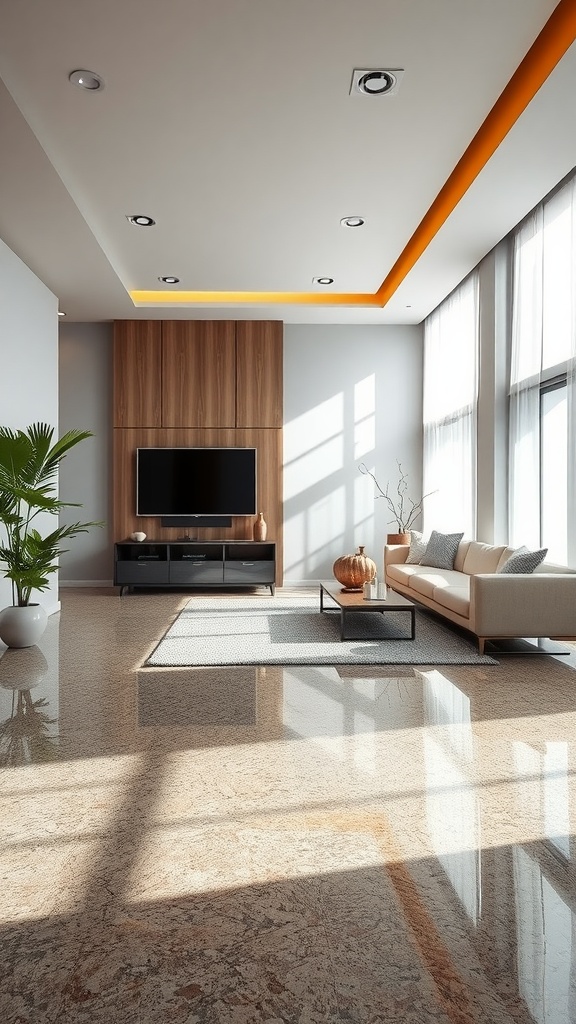
Epoxy flooring is made up of two main components: resin and hardener. In the image, you can see a bottle of resin prominently placed in the center. This resin is a key ingredient that, when mixed with a hardener, creates a strong and durable surface.
The resin acts as the primary bonding agent, while the hardener is what triggers the chemical reaction that leads to curing. This combination ensures that the flooring is not only tough but also resistant to stains and wear.
In many settings, especially industrial and commercial ones, the unique properties of epoxy flooring make it an attractive choice. The glossy finish seen in the image enhances the overall look and makes maintenance easier.
Understanding the composition helps in choosing the right type of epoxy for your specific needs, whether it’s for a garage, a kitchen, or even a commercial space. Both components are essential for achieving the final product that delivers durability and aesthetics.
Epoxy Flooring vs. Other Flooring Options
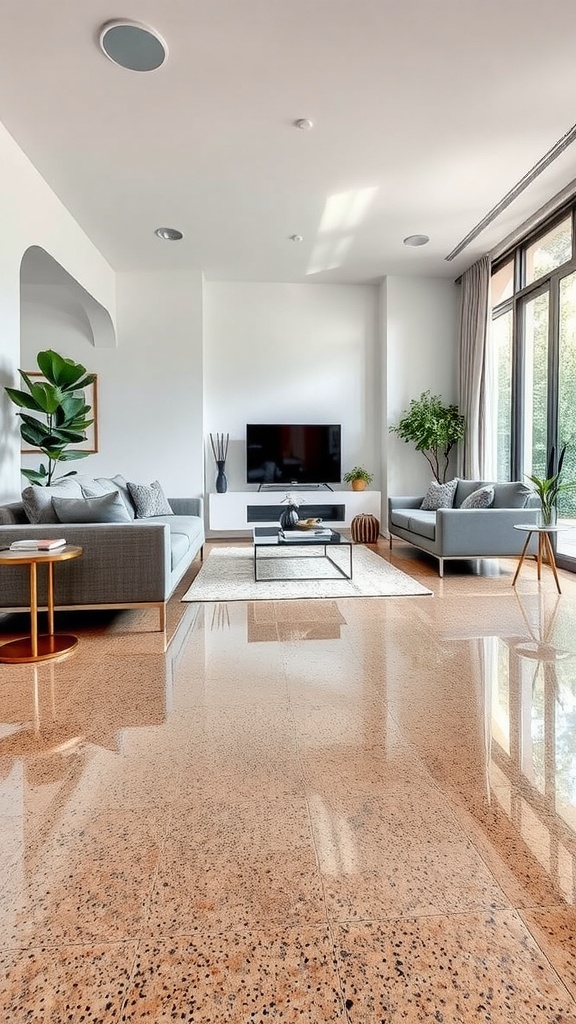
When choosing flooring, it’s good to know your options. The image shows a comparison of epoxy flooring with tiles and hardwood. Each type has its perks, making the choice a bit easier for you.
Let’s start with tiles. They’re pretty durable and come in many designs. If you're looking for something easy to clean, tiles might be your pick. They resist stains and are often waterproof, which is a plus in areas like kitchens and bathrooms.
Hardwood flooring is another popular choice. It offers a warm, classic look. While it may need more care than tiles, many love its natural beauty. It’s also quite sturdy, with the ability to last for decades if maintained well.
Now, epoxy flooring is in a league of its own. It’s super strong and can handle heavy traffic. Plus, it’s seamless, meaning no cracks or gaps for dirt or moisture to hide. If you want a unique look, epoxy can mimic various styles.
So, whether you're leaning toward tiles, hardwood, or epoxy, each has something special to offer. Think about your needs, and you’ll find the right fit for your space!
Maintaining Your Epoxy Floors for Longevity
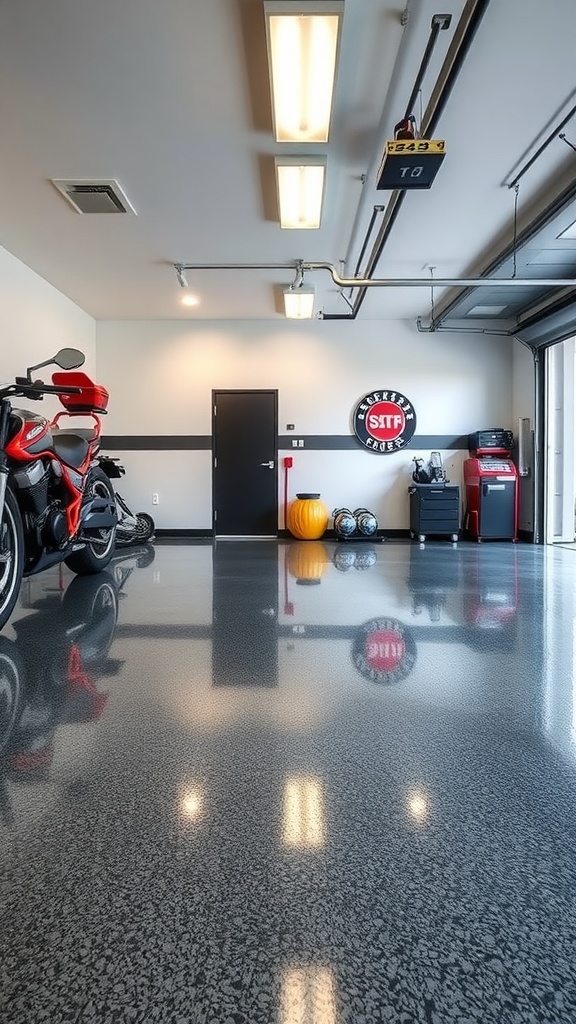
Keeping your epoxy floors looking fresh is key to their longevity. Regular cleaning is a must. In the image, you can see someone giving their floors a good mop. Using a microfiber mop or a soft-bristled broom helps protect your floor's surface.
Make sure to sweep or vacuum regularly to remove dust and debris. This prevents scratches and keeps your flooring shiny. When mopping, use a gentle cleaner that won't harm the epoxy finish. Avoid harsh chemicals, as they can dull the shine.
Another tip is to deal with spills immediately. Wipe them up quickly to avoid stains. If you notice scuffs, a simple damp cloth often does the trick. For tougher spots, try a little baking soda on the cloth.
Finally, placing mats at entryways can catch dirt before it reaches your floors. This small change can save you a lot of cleaning time in the long run. With a bit of effort, your epoxy floors can stay stunning for years to come!
Common Mistakes During Epoxy Flooring Application

Epoxy flooring can truly elevate a space, but it’s easy to make some common mistakes along the way. Take a look at the image, which highlights the difference between a poorly applied epoxy floor and one done right.
The top section shows a floor that has not been applied properly. You can spot mistakes in the finish and overall appearance. This can happen for several reasons, like not preparing the surface well or not mixing the epoxy correctly.
Now, look at the bottom section. This is what a correctly applied epoxy floor looks like. The colors blend beautifully, and the surface is smooth and shiny. Achieving this requires attention to detail, right from prep work to the final coat.
One common mistake is skipping surface preparation. If the floor isn’t clean and dry, the epoxy won’t adhere properly. Another frequent issue is not mixing the components thoroughly, leading to uneven curing and a lack of durability.
Make sure to follow the instructions closely and don’t rush the process. Taking the time to do things right can save you from a lot of headaches later on!
The Installation Process of Epoxy Flooring

Installing epoxy flooring is a straightforward process that can completely change the look of a space. In the image, we see a clean, well-lit garage with freshly installed epoxy flooring that showcases its durability and modern appeal.
The first step in the installation is preparing the surface. This includes cleaning, repairing cracks, and ensuring the floor is dry. A smooth surface is essential for the epoxy to bond properly.
Next comes the application of a primer. This helps the epoxy adhere better to the concrete. Once the primer is dry, the epoxy resin is mixed and poured onto the floor. It's important to work quickly, as the resin can begin to set fast.
The installer in the image is likely ensuring everything is even and smooth. After spreading the epoxy, it may be topped with decorative flakes for added texture and aesthetics.
Finally, the floor needs time to cure. This might take a few days, depending on the product used. Once cured, the epoxy flooring is not only visually appealing but also resistant to stains and impacts, making it ideal for garages.
Choosing the Right Epoxy Flooring Type for Your Needs
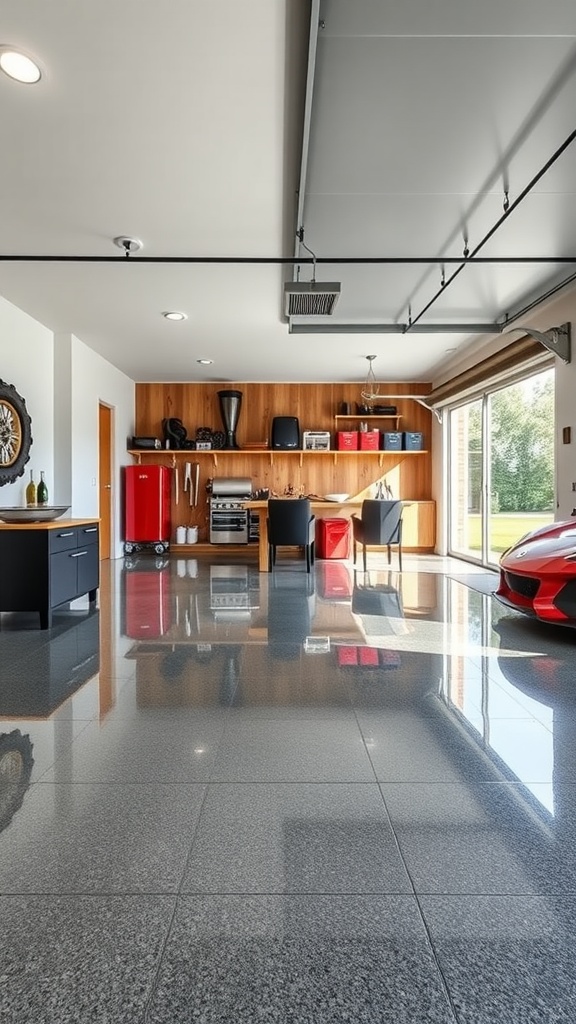
When picking the right epoxy flooring, visualizing the options can be a game changer. The image shows a selection of different flooring samples, each offering a unique style and finish. From the rich tones of wood to the sleek, modern look of stone, these choices can affect the overall feel of your space.
The samples laid out seem to cover various textures and colors. There’s a warm, reddish shade that might evoke a cozy environment, while a light speckled option could provide a fresh, clean look. Each type brings its own vibe, so think about how you want the area to feel.
Also visible is a measuring tape, hinting at the importance of dimensions in choosing your flooring. Epoxy can be custom-fitted to your space, making it crucial to get the measurements right. The layout plans on the side suggest planning ahead is key to achieving the perfect look and functionality.
Whether it’s for a garage, a kitchen, or a commercial space, understanding the different types of epoxy flooring helps you make a smart choice. Think about durability, aesthetics, and how each option fits into your lifestyle. It's worth taking the time to explore and find what suits you best!
Safety Considerations When Using Epoxy Flooring
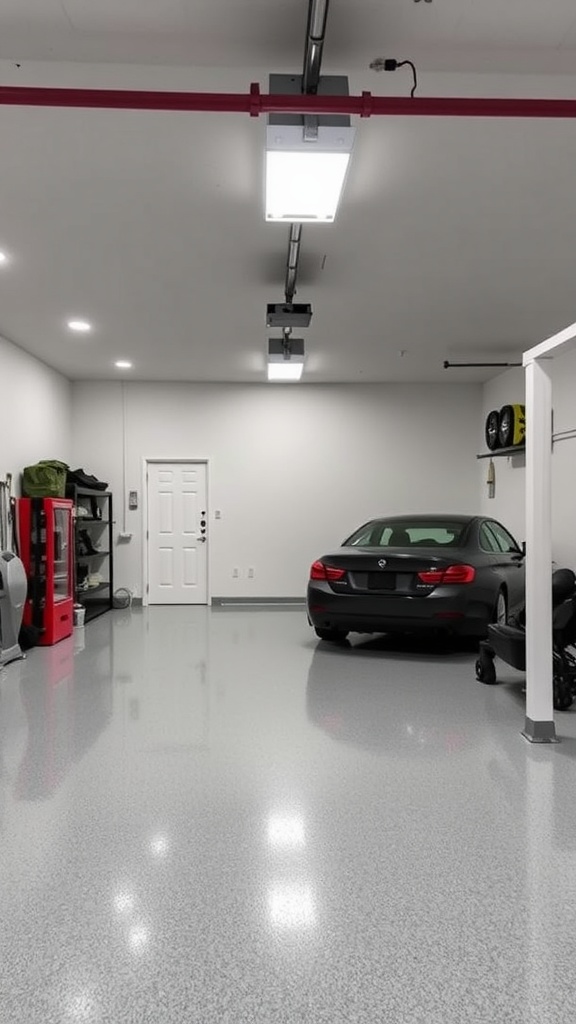
When working with epoxy flooring, safety should always be a top priority. The image shows some essential safety gear that anyone should wear during the process. You'll notice a pair of bright yellow gloves, a protective face shield, and a mask. All these items are crucial for keeping you safe from any harmful chemicals in the epoxy materials.
Wearing gloves protects your skin from irritating substances. The mask helps keep harmful fumes at bay. A face shield can guard your eyes from splashes and dust. These items may seem simple, but they play a big role in your safety.
It's also wise to work in a well-ventilated area. This ensures that any fumes disperse, keeping the air fresh. If you're in a confined space, consider using fans or opening windows. Your health matters, and taking these precautions makes a huge difference.
Lastly, always follow the manufacturer’s instructions. They'll provide specific guidelines to help you stay safe while using their products. Keep safety in mind, and you'll enjoy a smooth and worry-free epoxy flooring experience!
Trends in Epoxy Flooring Designs for 2023
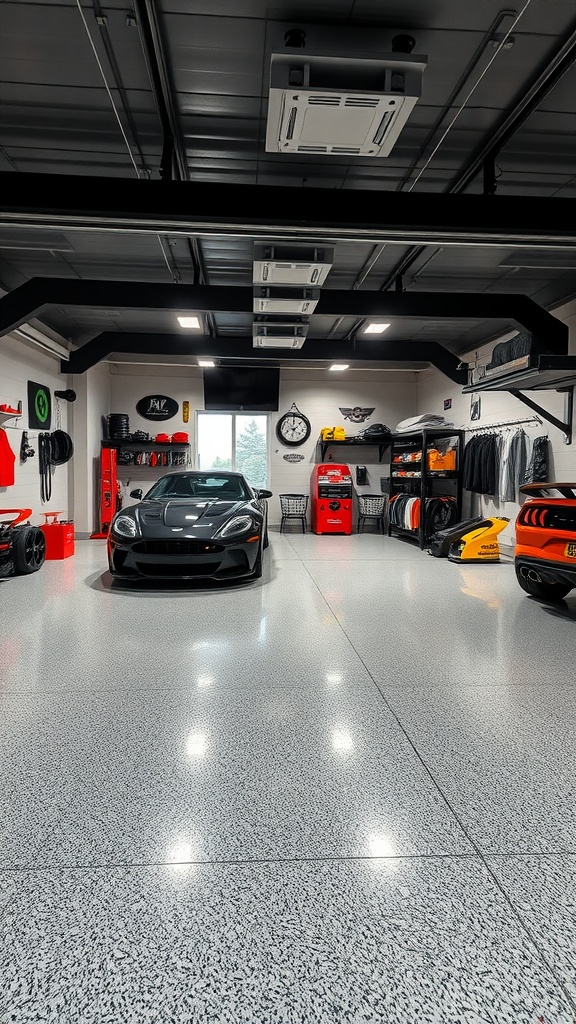
2023 is shaping up to be an exciting year for epoxy flooring. The image showcases a variety of styles, each with unique textures and colors, appealing to diverse tastes. From warm browns to cool grays, the palette is versatile and inviting.
The top left corner features a cozy living space with rich brown tones. This choice adds warmth and creates a welcoming atmosphere. Moving to the right, the sleek and modern kitchen highlights a clean, minimalist approach with light, bright finishes.
In the lower half of the image, we see designs that incorporate natural-looking textures, like stone and wood. This blend makes spaces feel more organic and connected to nature. The dining area with its warm wooden table complements the floor, making it a comfortable spot for gatherings.
Overall, the image represents the shift towards incorporating both functionality and style in flooring. Homeowners are looking for floor designs that not only look good but are also durable and easy to maintain. As we move through 2023, expect to see more creative uses of epoxy in homes, making each space unique.
Cost Analysis of Epoxy Flooring Installation
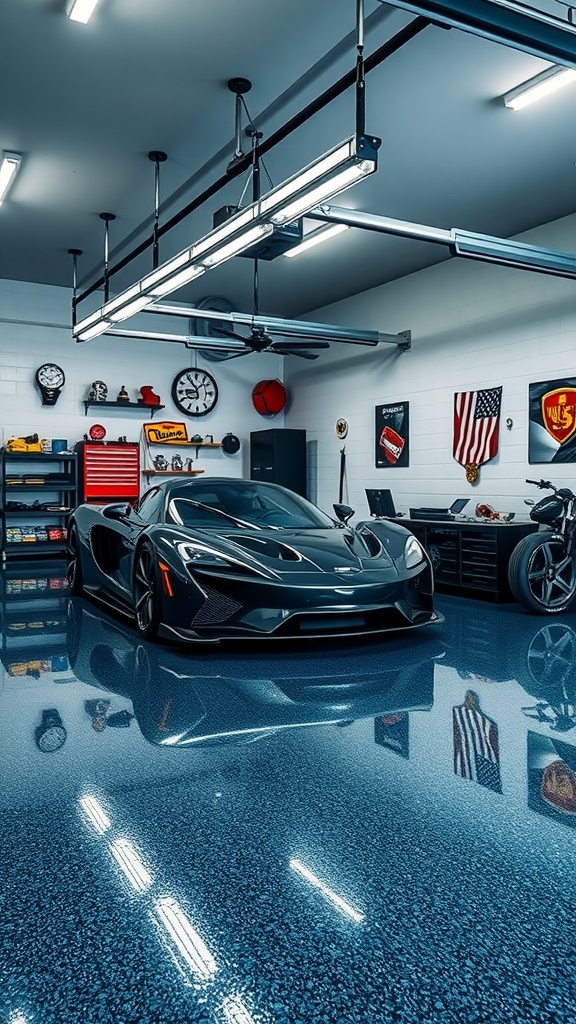
When you're thinking about epoxy flooring, understanding the costs involved is key. The image shows a colorful comparison of various installation prices. Each entry lists different types of epoxy flooring along with their respective costs, making it easy to see what options fit your budget.
The prices range widely, starting as low as $1 and going up to over $2,500. This variety allows for flexibility depending on what look you want and how much you’re willing to spend. For example, some are more budget-friendly while others offer more luxurious finishes.
It's important to keep in mind that the initial cost is just the start. Installation fees might vary, and you might also want to factor in maintenance costs down the line. Overall, knowing the full scope of costs can help you make a better choice for your space.
- Get link
- X
- Other Apps

Comments
Post a Comment